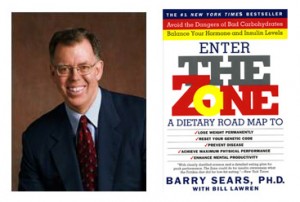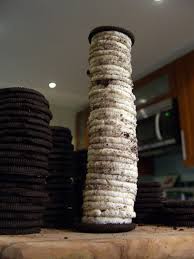 Dr. Barry Sears’ The Zone.
Dr. Barry Sears’ The Zone.
Unless you’ve lived under a rock for the past like 20 years, you’ve heard of Dr. Barry Sears’ The Zone eating plan. My husband and I actually quite successfully followed the prescriptions of this eating plan when it first was published, though we fell off the wagon because of the whole “calculate your blocks” thang.
What’s The Zone about?
In The Zone, you calculate “blocks” that are made up of macros. (If you don’t know what a macro is, scroll back a few blog posts or go HERE). There’s a good bit of math involved, but the idea is that you figure out how many “blocks” you should be eating in each meal in accordance with Dr. Sears’ plan, and then you stick to it. Each “block” is made up of a set amount of grams of each of the macronutrients (protein, carbs, fat). So if you’re having a “1 block meal” or a “3 block meal” you’re eating 1 (or 3) blocks (each) of protein, carbs, and fat.
It’s basically a set 40%-30%-30% thing at each meal – carbs-protein-fat – which is supposed to moderate your insulin response, and all sorts of other good stuff. (For a more detailed description, click HERE.)
How Do The Zone & Flexible Dieting Differ?
It’s quite likely that you would be eating a similar number of calories per day under either dietary road map.
However, in Flexible Dieting, Krissy Mae Cagney basically says “just get your macros when/ where/however you can” – and she doesn’t limit what you eat in the slightest. She also doesn’t have you “combine” foods.
So, for example, in discussing carbs, she basically says that “a carb is a carb” to your body. For example, she points out that if you eat a donut, your body is going to treat it as a super-fast acting carbohydrate (energy source) – which it would also do with something on the “high glycemic” scale like watermelon. But a “lower glycemic” carb – like say collard greens – is still a carb.
So, when it comes to carbs, a donut calorie = a watermelon calorie = a collard green calorie.

Instead of matching up protein/fat/carbohydrate “blocks” lock-step in each meal, Flexible Dieting is, in a word, flexible. As she points out (and I tend to agree with this), if you are on any eating plan and you fall off the wagon (e.g., suddenly waking up to find an empty chip bag in your hands and crumbs in the corners of your mouth), it’s human nature to just throw in the towel and go look for those Oreos you stashed behind the gluten-free, lactose-free, sweetener-free, soy-free, humanely-harvested-in-the-moonlight-by-vegan-fairies unsalted beet crisps.
The Zone’s proportions are pre-calculated for you without any real room to personalize, unless you are a super advanced Zone-er. So the Flexible Dieting/macro method is a less rigid approach, while still basically going after the same result.
Looking good…inside and out.
KMC does, of course, point out that while your body will “look great on the outside” if you stay in your macros (even if the carbs are all made up of Oreos), you’re not going to “look so great on the inside” – because there are carbs with way more “nutritional value” than what are otherwise generally thought of as “bad” carbs.
The Zone has huge lists of which protein/carbs/fats are “better” and which are “worse” – and (ahem) things like Oreos or Twinkies (do they still make Twinkies?) aren’t even on their list.
To KMC, a calorie of protein is a calorie of protein, a calorie of fat is a calorie of fat, and a calorie of carbohydrate is a calorie of carbohydrate.
In my own personal experience, I have found that “restrictive diets” like most everything but Flexible Dieting wind up with me on a bender. Then I sort of run out of gas (read: get too embarrassed to log what I ate), and stall out.
 As you know from my previous posts, I actually do eat “clean” (as the parlance goes), with a few notable exceptions (champagne being one of them). So I can’t even imagine what it would be like to be a “standard American” trying to go on some sort of eating regime. The delta (or “V”) between what you “ate before” and what you “are allowed to eat on the [non-Flexible Dieting] plan” is so great, it’s gotta act like a giant slingshot. You try and try and try and then when you see what you used to love (but which is now not allowed), *SPROING!*
As you know from my previous posts, I actually do eat “clean” (as the parlance goes), with a few notable exceptions (champagne being one of them). So I can’t even imagine what it would be like to be a “standard American” trying to go on some sort of eating regime. The delta (or “V”) between what you “ate before” and what you “are allowed to eat on the [non-Flexible Dieting] plan” is so great, it’s gotta act like a giant slingshot. You try and try and try and then when you see what you used to love (but which is now not allowed), *SPROING!*
That delta catapults you into an entire casserole pan of lasagne.
Which you’re too embarrassed to log.
And you stall out and head for the Oreos.
So, in sum,
Both The Zone and Flexible Dieting talk about figuring out a certain number of “macros” (grams of protein, fat, and carbohydrate) that you should be eating each day. In that way they are similar. However, Flexible Dieting lets you eat whatever you want, and doesn’t “combine” foods in any particular way.
As such, I’d suggest that if you’re thinking about “doing The Zone,” maybe you should actually start with Flexible Dieting. It will get you started with calculating your macros, looking at what you eat, etc. It will change the way that you’re eating now, no doubt about it. But it also will work with you, and what you eat now. After you get in the swing of Flexible Dieting, if you want to be more scientific about it with respect to things like insulin response, glycemic index, etc., then give The Zone a try.
Um, didn’t you say something about “divots”?
If you read this far, this is a little treat for you ;-)
Yesterday when I got up, I texted my Sculpt Buddy Claire that I could actually see my triceps. Now, I know there is a very fine line between “swole” and “swollen” (smile) – but that was a total first for me. Since most of my life I’ve either been a couch potato or an endurance-type athlete, the idea of a hunky upper body was never something I even entertained..
 On the final day of our Sculpt last week (day before yesterday), we had to do like 400 bejillion tricep-related exercises. (Well, that might be a little exaggerated. But only a little.) I couldn’t put my seatbelt on – Claire was considering carrying her backpack on the front of her body, ‘cos she couldn’t reach back into the straps.
On the final day of our Sculpt last week (day before yesterday), we had to do like 400 bejillion tricep-related exercises. (Well, that might be a little exaggerated. But only a little.) I couldn’t put my seatbelt on – Claire was considering carrying her backpack on the front of her body, ‘cos she couldn’t reach back into the straps.
Last night, my husband and I were watching something on Netflix, and he looked over at me, then looked over at me. All concerned, he poked me in the arm (okay, OWWWW) and said (cue Austrian accent): “Honey! You have a divot in your arm!”
I almost bust a gut laughing. Well, I would have, had I been able to laugh, but my stomach muscles hurt too much. So I snorted. A lot.
You’re welcome…
…for that little smile to add to your day!
Any other questions on this topic?
